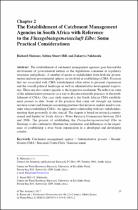 ResearchSpace
ResearchSpace
The establishment of Catchment Management Agencies in South Africa with reference to the Flussgebietsgemeinschaft Elbe: Some practical considerations
JavaScript is disabled for your browser. Some features of this site may not work without it.
- ResearchSpace
- →
- Research Publications/Outputs
- →
- Book Chapters
- →
- View Item
| dc.contributor.author |
Meissner, Richard

|
|
| dc.contributor.author |
Stuart-Hill, S

|
|
| dc.contributor.author |
Nakhooda, Z

|
|
| dc.date.accessioned | 2018-02-21T08:28:35Z | |
| dc.date.available | 2018-02-21T08:28:35Z | |
| dc.date.issued | 2016-10 | |
| dc.identifier.citation | Meissner, R., Stuart-Hill, S. and Nakhooda, Z. 2016. The establishment of Catchment Management Agencies in South Africa with reference to the Flussgebietsgemeinschaft Elbe: Some practical considerations. Freshwater Governance in the 21st Century, pp. 15-28 | en_US |
| dc.identifier.uri | http://hdl.handle.net/10204/10047 | |
| dc.description | Chapter published in Freshwater Governance in the 21st Century, pp. 15-28 | en_US |
| dc.description.abstract | The establishment of catchment management agencies goes beyond the involvement of governmental entities or the stipulations contained in regulatory structures and policies. A number of actors or stakeholders from both the governmental and non-governmental spheres are involved in establishing a CMA. Practices that are associated with CMA establishment often relate to personal experiences and the overall political landscape as well as administrative development trajectories. These are also context specific to the respective catchment. We reflect on some of the administrative processes as a way to discern noticeable practices in the establishment of CMAs. Our case study material is the South African CMA establishment process to date. Some of the practices that come out strongly are human resource issues and financial accounting practices that decision-makers need to consider when establishing CMAs. An appreciative relationship with key stakeholders, meeting them personally, is also crucial. The chapter is based on research commissioned and funded by South Africa’s Water Research Commission between 2014 and 2016. The process of establishing the Flussgebietsgemeinschaft Elbe in Germany is also outlined to illustrate the similarities and differences in the experience of establishing a river basin organisation in a developed and developing country. | en_US |
| dc.language.iso | en | en_US |
| dc.publisher | Springer | en_US |
| dc.relation.ispartofseries | Worklist;20282 | |
| dc.subject | Catchment management agency | en_US |
| dc.subject | Administrative process | en_US |
| dc.subject | Breede-Gouritz CMA | en_US |
| dc.subject | Inkomati-Usutu CMA | en_US |
| dc.subject | Lessons learnt | en_US |
| dc.title | The establishment of Catchment Management Agencies in South Africa with reference to the Flussgebietsgemeinschaft Elbe: Some practical considerations | en_US |
| dc.type | Book Chapter | en_US |
| dc.identifier.apacitation | Meissner, R., Stuart-Hill, S., & Nakhooda, Z. (2016). The establishment of Catchment Management Agencies in South Africa with reference to the Flussgebietsgemeinschaft Elbe: Some practical considerations., <i>Worklist;20282</i> Springer. http://hdl.handle.net/10204/10047 | en_ZA |
| dc.identifier.chicagocitation | Meissner, Richard, S Stuart-Hill, and Z Nakhooda. "The establishment of Catchment Management Agencies in South Africa with reference to the Flussgebietsgemeinschaft Elbe: Some practical considerations" In <i>WORKLIST;20282</i>, n.p.: Springer. 2016. http://hdl.handle.net/10204/10047. | en_ZA |
| dc.identifier.vancouvercitation | Meissner R, Stuart-Hill S, Nakhooda Z. The establishment of Catchment Management Agencies in South Africa with reference to the Flussgebietsgemeinschaft Elbe: Some practical considerations.. Worklist;20282. [place unknown]: Springer; 2016. [cited yyyy month dd]. http://hdl.handle.net/10204/10047. | en_ZA |
| dc.identifier.ris | TY - Book Chapter AU - Meissner, Richard AU - Stuart-Hill, S AU - Nakhooda, Z AB - The establishment of catchment management agencies goes beyond the involvement of governmental entities or the stipulations contained in regulatory structures and policies. A number of actors or stakeholders from both the governmental and non-governmental spheres are involved in establishing a CMA. Practices that are associated with CMA establishment often relate to personal experiences and the overall political landscape as well as administrative development trajectories. These are also context specific to the respective catchment. We reflect on some of the administrative processes as a way to discern noticeable practices in the establishment of CMAs. Our case study material is the South African CMA establishment process to date. Some of the practices that come out strongly are human resource issues and financial accounting practices that decision-makers need to consider when establishing CMAs. An appreciative relationship with key stakeholders, meeting them personally, is also crucial. The chapter is based on research commissioned and funded by South Africa’s Water Research Commission between 2014 and 2016. The process of establishing the Flussgebietsgemeinschaft Elbe in Germany is also outlined to illustrate the similarities and differences in the experience of establishing a river basin organisation in a developed and developing country. DA - 2016-10 DB - ResearchSpace DP - CSIR KW - Catchment management agency KW - Administrative process KW - Breede-Gouritz CMA KW - Inkomati-Usutu CMA KW - Lessons learnt LK - https://researchspace.csir.co.za PY - 2016 T1 - The establishment of Catchment Management Agencies in South Africa with reference to the Flussgebietsgemeinschaft Elbe: Some practical considerations TI - The establishment of Catchment Management Agencies in South Africa with reference to the Flussgebietsgemeinschaft Elbe: Some practical considerations UR - http://hdl.handle.net/10204/10047 ER - | en_ZA |





